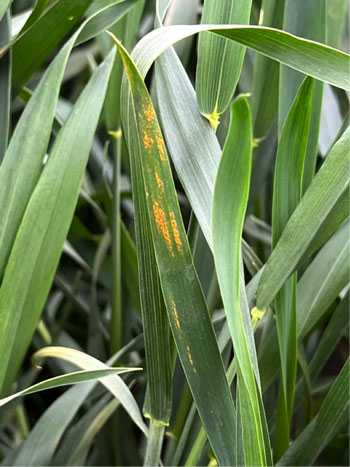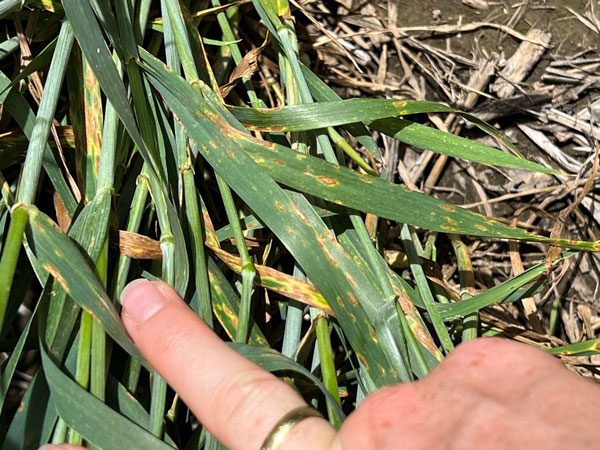Stripe rust was detected this week in irrigated wheat in Edwards County, Kansas. This is the first report that we’ve received in the state this season. Extremely dry conditions have remained unfavorable for stripe rust development. This report is much later than the first detections in previous years. Late arrival, dry conditions, and low levels of disease in Texas and Oklahoma make it unlikely that stripe rust will gain traction in the state this year. Although we have been scouting intensively, leaf rust has not yet been reported in the state.

Figure 1. Classic symptoms of stripe rust. Please note that this is not a photo taken during this season. Photo by Kelsey Andersen Onofre, Department of Plant Pathology, K-State Research and Extension.
Recent rain showers in some areas have led to low levels of tan spot (Figure 2) showing up in the state, particularly in wheat-on-wheat fields. Observed pressure has been low and not affecting the flag leaves.

Figure 2. Low levels of tan spot have shown up sporadically throughout the state.
We have been monitoring the risk for Fusarium head blight (scab) as the crop moves through flowering in the state. There is slightly elevated risk in some south central and southeastern counties (Figure 3), although these parts of the state may be past the critical stages for infection. As a reminder, the wheat crop is most susceptible to scab during flowering (when yellow anthers are present). Early flowering (Feekes 10.5.1) is the optimal timing for a scab fungicide application. We will continue to report risk as the rest of the state moves through the flowering growth stage.
If you are considering a fungicide application for scab, it may be a good idea to prioritize fields with yield potential greater than 40 bu/acre, under irrigation, or fields being used for seed production. With much of the wheat crop this season in poor condition, many fields will not meet these conditions.
Fungicides such as Prosaro, Caramba, Proline, or Miravis Ace are known to suppress scab (see a more complete list here: https://bookstore.ksre.ksu.edu/pubs/ep130.pdf). Other fungicides are not labeled or not recommended for scab control. These fungicides are most effective against scab when applied at early flowering (Feekes 10.5.1), but can provide protection even when applied later in the flowering window. It is important to pay attention to pre-harvest intervals at this point of the season and follow guidelines provided on product labels. The products listed above have either a 30-day pre-harvest interval (cannot be applied within 30 days of harvest) or cannot be applied after Feekes 10.5.4 (end of flowering, watery ripe growth stage).
It is important to remember that early flag-leaf fungicide applications will have little to no effect on scab.

Figure 3. Fusarium head blight (Scab) risk forecast for the next 6 days after May 11 according to wheatscab.psu.edu. This model is calibrated for very susceptible varieties, which should be prioritized for a fungicide application. Yellow indicates low risk, while red indicates elevated risk.
Please contact us if you detect stripe or leaf rust so we can update regional risk maps.
Kelsey Andersen Onofre, Extension Wheat Pathologist
andersenk@ksu.edu
Tags: wheat disease stripe rust fusarium head blight tan spot